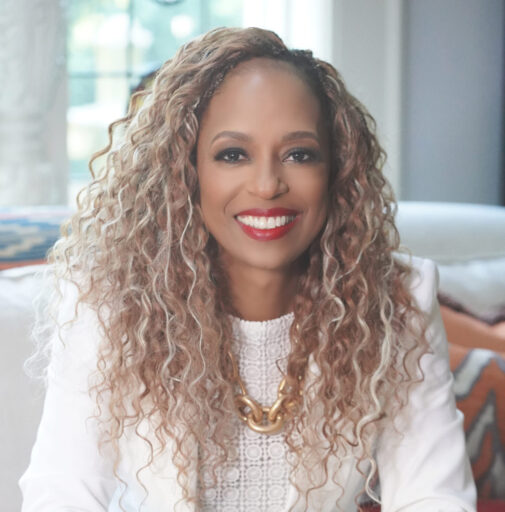Since joining Children’s Mercy Kansas City in September 2020, chief diversity officer Michelle Wimes has been working to execute a new strategic plan that focuses on employee diversity, marketplace vendor diversity, inclusive company behaviors, and an inclusive patient community culture. This is a huge feat to manage hospital-wide, given the multitude of cultures with 115 different languages that make up the community of patients and families.
“You’re looking at your suppliers and your vendors but then you also have this big community piece which can be intimidating to be quite honest. You’re talking about: how are we eliminating health care inequities and what kinds of things can we put in place to address food insecurity, transportation and security, infant mortality,” says Wimes.
Fortunately, the team has seen these challenges as an opportunity to partner with community organizations. The hospital has worked with the Civic Council in Kansas City to learn about diverse vendors, the Hunger Free Hospital Council on food insecurity issues, and invested in Greenline Initiative to tackle housing insecurity. Additionally, Wimes has led three assessments to measure DEI: a diversity workforce assessment, a Physician Provider Cross Cultural Medical assessment, and a Language Access Audit.
Read on for an edited excerpt of our exclusive interview with Michelle Wimes about the DEI strategy at Children’s Mercy and the three assessments they’ve developed to tackle it.
Senior Executive Media: Where does DEI sit within the hospital?
Michelle Wimes: My boss is the chief strategy and innovation officer, Dr. Rob Steele. He reports directly to Paul Kempinski, the CEO. And then I report to the chief strategy and innovation officer, so I’m one level removed from the CEO. But I am one of the senior vice presidents in the organization, out of 12 senior vice presidents. My position is a hospital-wide position, so it’s not just for a particular division like the department of pediatrics. It is system-wide. I govern both staff and patient-facing staff as well.
We have more than doubled in size since I’ve been here. I started out with I think six employees and I now have 13. Once we built out the strategic plan, we realized that we needed additional staff to really help us to make progress… The fact that they’ve been willing to make that investment has been huge. To have a staff of 13 is unheard of. Part of it is because our breadth is such that we’re covering not only the workforce piece, but we’re also covering health inequities and community patients and families.
“I’m just a strong believer in following the data, understanding what the data is telling you, and just trying to approach DEI from an evidence based perspective rather than anecdotally.”
Senior Executive Media: What are some of the job titles of your core staff?
Michelle Wimes: I’ve got a health equity specialist. That is a new position that focuses on my community patients’ families. I have a [DEI] data analyst that helps us with the dashboards — the supplier diversity dashboard and the workforce dashboard that we have. I have a program director that helps with a number of the programs that we institute with our community partners. I have an office of equity and diversity director who is right under me and helps to direct our staff. I have a medical director and I have a culture and language coaching program director. Then, I have a program manager of health literacy and nursing bioethics who actually spends part of her time in DEI and part of her time in health literacy and bioethics. Then of course, we have an executive assistant, an office manager, and different administrative folks.
Senior Executive Media: What does the workforce dashboard look like?
Michelle Wimes: We’re looking at, who are the folks that are currently employed at Children’s Mercy? What is the position that is open? Who are the applicants who are applying for this position? What are the demographics of those applicants? And then looking to see, do those folks then fit within the criteria of this particular job? We’ve looked over this past year and I think we were at around 33% diversity. It was surprising to me that at that director level and above, we were at 33% over this past year in terms of the folks that were diverse, because we tend to be a pretty female dominated profession, generally speaking, so a number of our nurses and social workers and childlife folks are women. The challenge is really that racial and ethnic diversity is what we’re looking at.
I don’t know if that was an anomaly because we don’t really have data going back prior years, so we are going to keep [the goal] at 30% for this first couple of years. And then eventually we’d like to expand it and start to look at okay, well, what does that look like in the executive ranks? Because this is for Children’s Mercy staff that are non-clinician based, we’re not looking at our patient-facing positions. These are folks that are on the administrative side of things. So eventually we’d like to expand it out and look at patient-facing positions as well… We have a new initiative that we want to launch next spring — we’re working on an internal job fair for candidates in conjunction with our talent acquisition in our HR department.
Senior Executive Media: What are some key focus areas right now for you as a DEI leader?
Michelle Wimes: What I’ve been focused on is really developing a DEI strategic plan for the organization. We did not have a DEI-specific plan that rolled up to the larger strategic plan of the organization. And so in order to create that, one thing that we’ve been focused on is evidence-based diversity, looking to see what the metrics are and looking to see what the evidence teaches us about the areas of focus that we need to focus on.
One of the first things that we did was we launched a diversity workforce assessment, and that looked at our management’s commitment to diversity, equity, and inclusion. It looked at our culture and our climate. It looked at our employees, perceptions of the care that we provide to our culturally and linguistically diverse patients and families. From that assessment, we were able to develop that plan. That plan has four key components or four prongs. We’re focused on having a diverse workforce — that we’re recruiting from all different areas, that the folks that are here are able to progress, they’re able to advance. That they’re able to feel like they belong in the workplace is the other component of that, and that is our culture and our behaviors. Making sure that we have a respectful workplace and we have a workplace where people can thrive right and it’s one that focuses on inclusion marketplace.
Another problem is our relationship with our suppliers and our vendors. That’s looking at: are we eliminating barriers so that people can do business with us? Who may have been shut out in the past for whatever reasons? We’re focused on women-owned businesses, minority-owned businesses, which includes racial and ethnic businesses as well as LGBTQ-, disability-, and veteran-owned businesses. Then the fourth prong, which I think is the most important, is our community. It’s our patients and families. What are we doing to eliminate healthcare disparities and equities? How are we interfacing with the community organizations that also serve our patients and families? And how are we providing quality care to all of our patients and families no matter what their demographics, no matter what their backgrounds are, or their zip codes for that matter?
Senior Executive Media: How did you create the diversity workforce assessment?
Michelle Wimes: It was a survey that went out to all 8,200-8,300 employees at that time. It was a confidential assessment, and we hired an outside consulting firm to actually help us to manage that because we wanted to make sure that people knew that we would not have access to the underlying data. The data would be analyzed by an outside firm, just to make sure that people felt comfortable being candid and totally honest. We launched that in February of 2021. We had a 60% response rate. The partner — the consulting firm that we work with, BCT Partners — had done this on a number of hospital systems across the country, and the highest response rate they had received was 45%… We were able to really dive down into the data that we received, share that data with our executive team, our board of directors, and with our medical administration leadership.
The consulting group also did focus group interviews, to kind of put some meat on the bones for the qualitative/quantitative data that came out of the assessment. I think they did eight or nine different focus groups… Then I did five different community listening sessions and had people from the local school district that serve a lot of our patients and families, local clinics that serve patients and families through a number of organizations like the Guadalupe Center, an educational center and a resource center for our Hispanic and Latino community here. I would say there were over 70 agencies or community organizations that we invited to those, and we had about 150 folks through those four different sessions that showed up and gave us input. We were able to take the assessment results, the focus group results, and the community listening results and tie all of that into this new strategic plan.
Senior Executive Media: What were some of the key findings that you had?
Michelle Wimes: Unfortunately, we were able to discover that our workforce had high degrees of incivility and disrespect, not just among our employees, but among the patients and families, their behavior toward our employees. So one of the first things that we got busy doing was we felt the need to develop a Respect For All guide. And this was a guide that outlined our expectations for how our patients and families should treat us and how we should treat each other. That was a really big thing that we ended up doing. We are in the process now of augmenting that even further because we’ve had a number of instances of discriminatory behavior… that has surfaced with some of our patients and families in the emergency department particularly… As you can imagine, with COVID and now with RSV and all of that, there’s just an incredible stress on our patients and families. When they show up to our doors they already have anxiety and stress. And then in some instances, we’re not able to see them right away just because of the high demand, and so it just leads to some bad behavior, sometimes bordering on discriminatory comments and things to our providers. We really had to step it up, and we’re going to be rolling out here in the next month or so.
[For] our emergency department folks we put together a team of experts that can be deployed when there is [a scenario with a patient or family member]. We’re calling it the code vest team, which is our visitor escalation safety team — it consists of social workers, our security department, and our well-being department. It’s folks that can come and provide support in the moment to our staff, our patients, and families to the extent that there may need to be some resources that are provided to those patients or to those families to de-escalate. We’re in the process of putting that together, putting together some scenarios and simulations that people can do and practice for how to respond in the moment. There’s a little sticker on the badge with a code so that when folks scan the QR code with their phones, it automatically pops up the guide, the case scenarios, and things like that, that could support [employees] in the moment.
Senior Executive Media: So the QR codes are an employee resource – what about for patients?
Michelle Wimes: We will have some posters around the hospital for patients with a QR code that they can scan that will provide resources for them as well. We’re trying to make it a multi-faceted, multi-pronged approach that deals not only with our workforce, but also with our patients and families.
From our culturally and linguistically diverse workforce, there are perceptions that our culturally and linguistically diverse patients and families don’t always get the same top-shelf quality treatment that perhaps patients and families from the majority environment do. One of the things that we’ve done as an outgrowth of that is we launched another assessment that just happened this fall, and we’re in the process of rolling out those results as well. The Physician Provider Cross Cultural Medical assessment asks our physicians and our providers to assess themselves on how ready they are to respond to the needs of culturally and linguistically diverse patients in a globally mobile workforce… We’re seeing patients and families from all different backgrounds. We asked them, what [are] your feelings regarding health care disparities? What’s your training in cross-cultural medicine? How have you approached dealing with limited English-proficient patients, deaf and hard of hearing patients, LGBTQ patients, patients with disabilities? We were able to identify gaps, and so we now are in the process of rolling out those results, and there’ll be some education and training that comes from that.
Last time I checked, we had 115 different languages. It is definitely something that we need to get on top of… Chuukese is one of those languages. That is what they call language of lesser diffusion — it’s just not very prominent, and yet we’re starting to see an increase in the Chuukese population. We’re trying to figure out how we serve these folks when we don’t have folks who can [translate] in person. We’re having to use video, remote, telephonic interpreter services and having to contract with outside providers who can do that for us. That’s been a challenge.
There is one other assessment that we did in the spring of this year, and it was a Language Access Audit. That’s where we audited our policies and our practices for serving our limited English-proficient and our immigrant and refugee patients and families. We looked to see there are a lot of policies that we will need to update as a result of that. We need to combine some of those policies as we found some duplications as well. Having an expert, like BCT, a consulting firm, to be able to do all three of those assessments has just been paradigm shifting for our organization. I think a lot of DEI efforts focus on just the workforce piece — you’re looking at your culture, you’re looking at your climate. These assessments have been more holistic and have allowed us to look at: what are our physicians and our providers doing? What are our policies stating with regard to health equity. And how can we bring all three of those together underneath this DEI strategic plan?







